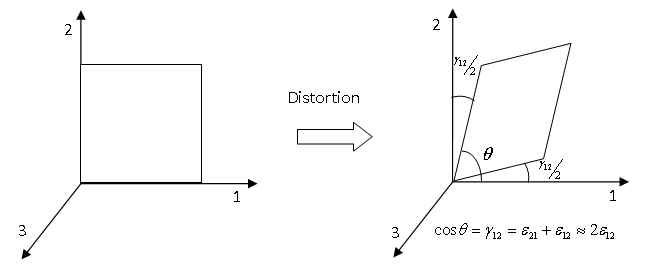/MAT/LAW12 (3D_COMP)
Block Format Keyword This law describes a solid material using the Tsai-Wu formulation that is usually used to model composites. This material is assumed to be 3D orthotropic-elastic before the Tsai-Wu criterion is reached.
The material becomes nonlinear afterwards. The Tsai-Wu criterion can be set dependent on the plastic work and strain rate in each of the orthotropic directions and in shear to model material hardening. Stress based orthotropic criterion for brittle damage and failure is available. This material is a generalization and improvement of /MAT/LAW14 (COMPSO).
Format
| (1) | (2) | (3) | (4) | (5) | (6) | (7) | (8) | (9) | (10) |
|---|---|---|---|---|---|---|---|---|---|
| /MAT/LAW12/mat_ID/unit_ID or /MAT/3D_COMP/mat_ID/unit_ID | |||||||||
| mat_title | |||||||||
| E11 | E22 | E33 | |||||||
| G12 | G23 | G31 | |||||||
| B | n | fmax | |||||||
| Ef | c | ||||||||
Definitions
| Field | Contents | SI Unit Example |
|---|---|---|
| mat_ID | Material
identifier. (Integer, maximum 10 digits) |
|
| unit_ID | Unit Identifier. (Integer, maximum 10 digits) |
|
| mat_title | Material
title. (Character, maximum 100 characters) |
|
| Initial density. (Real) |
||
| E11 | Young's modulus in direction
1. (Real) |
|
| E22 | Young's modulus in
direction 2. (Real) |
|
| E33 | Young's modulus in
direction 3. (Real) |
|
| Poisson's ratio between
directions 1 and 2. (Real) |
||
| Poisson's ratio between
directions 2 and 3. (Real) |
||
| Poisson's ratio between
directions 3 and 1. (Real) |
||
| G12 | Shear modulus in direction
12. (Real) |
|
| G23 | Shear modulus in direction
23. (Real) |
|
| G31 | Shear modulus in direction
31. (Real) |
|
| Stress at the beginning of
composite tensile/compressive failure in direction 1. 4 Default = 1030 (Real) |
||
| Stress at the beginning of
composite tensile/compressive failure in direction 2. 4 Default = (Real) |
||
| Stress at the beginning of
composite tensile/compressive failure in direction 3. 4 Default = (Real) |
||
| Maximum damage factor.
4 Default = 0.05 (Real) |
||
| B | Global plastic hardening
parameter. 3 (Real) |
|
| n | Global plastic hardening
exponent. Default = 1.0 (Real) |
|
| Maximum value of the
Tsai-Wu criterion limit. 3 Default = 1010 (Real) |
||
| Reference plastic work per
unit solid volume. Default = 1.0 (in local unit system) (Real) |
||
| Yield stress in tension in
direction 1. 3 Default = 0.0 (Real) |
||
| Yield stress in tension in
direction 2. Default = 0.0 (Real) |
||
| Yield stress in
compression in direction 1. Default = 0.0 (Real) |
||
| Yield stress in
compression in direction 2. Default = 0.0 (Real) |
||
| Yield stress in tensile
shear in direction 12. Default = 0.0 (Real) |
||
| Yield stress in
compressive shear in direction 12. Default = 0.0 (Real) |
||
| Yield stress in tensile
shear in direction 23. Default = 0.0 (Real) |
||
| Yield stress in
compressive shear in direction 23. Default = 0.0 (Real) |
||
| α | Fiber volume fraction.
5 (Real) |
|
| Ef | Fiber Young's modulus.
5 (Real) |
|
| c | Global strain rate coefficient.
(Real) |
|
| Reference strain
rate. (Real) |
||
| ICC | Strain rate effect flag.
3
(Integer) |
Example (Carbon)
#RADIOSS STARTER
#---1----|----2----|----3----|----4----|----5----|----6----|----7----|----8----|----9----|---10----|
/UNIT/1
unit for mat
Mg mm s
#---1----|----2----|----3----|----4----|----5----|----6----|----7----|----8----|----9----|---10----|
#- 2. MATERIALS:
#---1----|----2----|----3----|----4----|----5----|----6----|----7----|----8----|----9----|---10----|
/MAT/LAW12/1/1
carbon
# RHO_I
1.5E-9
# E11 E22 E33
64000 60000 5000
# NU12 NU23 NU31
.07 .07 .07
# G12 G23 G31
4000 2000 2000
# sigma_t1 sigma_t2 sigma_t3 delta
0 0 0 0
# B n fmax Wpref
50 .5 0 0
# sigma_1yt sigma_2yt sigma_1yc sigma_2yc
600 500 600 600
# sigma_12yt sigma_12yc sigma_23yt sigma_23yc
100 100 30 30
# sigma_3yt sigma_3yc sigma_13yt sigma_13yc
50 50 100 100
# alpha Ef c EPS_RATE_0 ICC
0 0 0 0 0
#---1----|----2----|----3----|----4----|----5----|----6----|----7----|----8----|----9----|---10----|
#ENDDATA
/END
#---1----|----2----|----3----|----4----|----5----|----6----|----7----|----8----|----9----|---10----|Comments
- This material requires an orthotropic solid property (/PROP/TYPE6 (SOL_ORTH), /PROP/TYPE21 (TSH_ORTH), or /PROP/TYPE22 (TSH_COMP). It can only be used with solid elements for a 3-dimensional analysis. This law is compatible with 10-node tetrahedron and 4-node tetrahedron elements. The orthotropic material directions are set in the property entries.
- Stress-strain relation in
elastic phase.The stresses and strains are related as:
(1) (2) (3) (4) Where,- Strains
- Stresses
- , and
- Distortions in the corresponding material directions

Figure 1. - Tsai-Wu criterion:The material is assumed to be elastic until the Tsai-Wu criterion is fulfilled. After exceeding the Tsai-Wu criterion limit , the material becomes nonlinear:
- If : elastic
- If : nonlinear
Where,- Stress
in element for Tsai-Wu criterion
computed as:
(5)
The coefficients of the Tsai-Wu criterion are determined from the limiting stresses when the material becomes nonlinear in directions 1, 2, 3 or 12, 23, 31 (shear) in compression or tension as:-
is the variable Tsai-Wu criterion
limit defined:
(6) Where,- Reference plastic work
- Relative plastic work
- Plastic hardening parameter
- Plastic hardening exponent
- Reference true strain rate
- Strain rate coefficient
the maximum value of the Tsai-Wu criterion limit depends on ICC:- If ICC=1
- If ICC=2
Where,
- Stress damage:When the limiting stress value of is reached in tension, the corresponding stress value is scaled as . The value of damage is updated on each time step with incremental damage parameter .
(7) After reaches the value of 1, the stress in corresponding direction is set to 0. The damage is irreversible, that is, if a value of is attained the material will not reach any lower damage value.
- Fiber reinforcement:
These parameters allow you to define additional fiber reinforcement in the 11 direction. Additional stress in direction 11 will be added equal to .